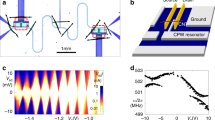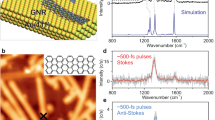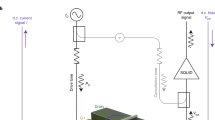Abstract
The interplay between discrete vibrational and electronic degrees of freedom directly influences the chemical and physical properties of molecular systems. This coupling is typically studied through optical methods such as fluorescence, absorption and Raman spectroscopy. Molecular electronic devices provide new opportunities for exploring vibration–electronic interactions at the single molecule level1,2,3,4,5,6. For example, electrons injected from a scanning tunnelling microscope tip into a metal can excite vibrational excitations of a molecule situated in the gap between tip and metal7. Here we show how current directly injected into a freely suspended individual single-wall carbon nanotube can be used to excite, detect and control a specific vibrational mode of the molecule. Electrons tunnelling inelastically into the nanotube cause a non-equilibrium occupation of the radial breathing mode, leading to both stimulated emission and absorption of phonons by successive electron tunnelling events. We exploit this effect to measure a phonon lifetime of the order of 10 ns, corresponding to a quality factor of well over 10,000 for this nanomechanical oscillator.
This is a preview of subscription content, access via your institution
Access options
Subscribe to this journal
Receive 51 print issues and online access
$199.00 per year
only $3.90 per issue
Buy this article
- Purchase on Springer Link
- Instant access to full article PDF
Prices may be subject to local taxes which are calculated during checkout




Similar content being viewed by others
References
Park, H. et al. Nanomechanical oscillations in a single-C60 transistor. Nature 407, 57–60 (2000)
Pasupathy, A. N. et al. Vibration-assisted electron tunneling in C140 single-molecule transistors. Preprint at 〈http://arxiv.org/cond-mat/0311150〉 (2003).
Park, J. et al. Coulomb blockade and the Kondo effect in single-atom transistors. Nature 417, 722–725 (2002)
Zhitenev, N. B., Meng, H. & Bao, Z. Conductance of small molecular junctions. Phys. Rev. Lett. 88, 226801 (2002)
Qiu, X. H., Nazin, G. V. & Ho, W. Vibronic states in single molecule electron transport. Phys. Rev. Lett. 92, 206102 (2004)
Weig, E. M. et al. Single-electron-phonon interaction in a suspended quantum dot phonon cavity. Phys. Rev. Lett. 92, 046804 (2004)
Stipe, B. C., Rezaei, M. A. & Ho, W. Single-molecule vibrational spectroscopy and microscopy. Science 280, 1732–1735 (1998)
LeRoy, B. J., Lemay, S. G., Kong, J. & Dekker, C. Scanning tunneling spectroscopy of suspended single-wall carbon nanotubes. Appl. Phys. Lett. 84, 4280–4282 (2004)
Grabert, H. & Devoret, M. H. Single Charge Tunneling (Plenum, New York, 1992)
Liang, W. J., Bockrath, M. & Park, H. Shell filling and exchange coupling in metallic single-walled carbon nanotubes. Phys. Rev. Lett. 88, 126801 (2002)
Cobden, D. H. & Nygard, J. Shell filling in closed single-wall carbon nanotube quantum dots. Phys. Rev. Lett. 89, 046803 (2002)
Venema, L. C., Meunier, V., Lambin, Ph. & Dekker, C. Atomic structure of carbon nanotubes from scanning tunneling microscopy. Phys. Rev. B 61, 2991–2996 (2000)
Dresselhaus, M. S. & Eklund, P. C. Phonons in carbon nanotubes. Adv. Phys. 49, 705–814 (2000)
Vitali, L. et al. Phonon spectromicroscopy of carbon nanostructures with atomic resolution. Phys. Rev. Lett. 93, 136103 (2004)
Iliev, M. N., Litvinchuk, A. P., Arepalli, S., Nikolaev, P. & Scott, C. D. Fine structure of the low-frequency Raman phonon bands of single-wall carbon nanotubes. Chem. Phys. Lett. 316, 217–221 (2000)
Reulet, B. et al. Acoustoelectric effects in carbon nanotubes. Phys. Rev. Lett. 85, 2829–2832 (2000)
Cleland, A. Foundations of Nanomechanics (Springer, Berlin, 2003)
Tien, P. K. & Gordon, J. P. Multiphoton process observed in the interaction of microwave fields with the tunneling between superconductor films. Phys. Rev. 129, 647–651 (1963)
Hanna, A. E. & Tinkham, M. Variation of the Coulomb staircase in a two-junction system by fractional electron charge. Phys. Rev. B 44, 5919–5922 (1991)
Acknowledgements
We thank Ya. M. Blanter for discussions, and NWO and FOM for funding.
Author information
Authors and Affiliations
Corresponding author
Ethics declarations
Competing interests
The authors declare that they have no competing financial interests.
Rights and permissions
About this article
Cite this article
LeRoy, B., Lemay, S., Kong, J. et al. Electrical generation and absorption of phonons in carbon nanotubes. Nature 432, 371–374 (2004). https://doi.org/10.1038/nature03046
Received:
Accepted:
Issue Date:
DOI: https://doi.org/10.1038/nature03046
This article is cited by
-
Vibron-assisted spin excitation in a magnetically anisotropic molecule
Nature Communications (2020)
-
Non-linear phonon Peltier effect in dissipative quantum dot systems
Scientific Reports (2018)
-
Rethinking phonons: The issue of disorder
npj Computational Materials (2017)
-
Giant electron-hole transport asymmetry in ultra-short quantum transistors
Nature Communications (2017)
-
Structures and electrical properties of single nanoparticle junctions assembled using LaC2-encapsulating carbon nanocapsules
Scientific Reports (2016)
Comments
By submitting a comment you agree to abide by our Terms and Community Guidelines. If you find something abusive or that does not comply with our terms or guidelines please flag it as inappropriate.



